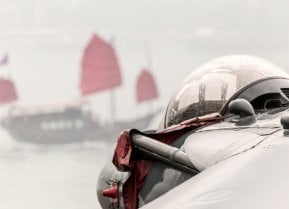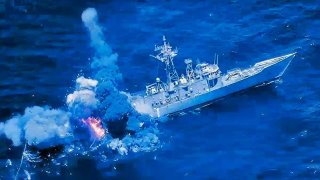Warship Destroyed: Watch a Navy Frigate Get Hit By an Anti-Ship Ballistic Missiles
In 2022, the decommissioned USS Rodney M. Davis (FFG-60), an Oliver Hazard Perry-class guided-missile frigate, was used in a live-fire exercise (SINKEX) during the Rim of the Pacific (RIMPAC) drills.
Summary and Key Points: In 2022, the decommissioned USS Rodney M. Davis (FFG-60), an Oliver Hazard Perry-class guided-missile frigate, was used in a live-fire exercise (SINKEX) during the Rim of the Pacific (RIMPAC) drills.
-The warship, retired in 2015, was sunk by anti-ship missiles in a controlled exercise to enhance tactical proficiency among partner navies. The exercise provided realistic training for the 26 participating nations.
-The U.S. Navy ensures that all vessels used in SINKEX are prepared according to strict environmental guidelines, including cleaning and removal of hazardous materials, before being sunk in deep waters.
Decommissioned U.S. Frigate Sunk in RIMPAC 2022: Realistic Combat Training
Earlier in 2022, the USS Rodney M. Davis (FFG-60), an Oliver Hazard Perry-class guided missile frigate, was hit and sunk by anti-ship missiles. Considering how the Houthis are using such weapons in the Red Sea, such tests could be of significant value.
Unlike the Russian Navy's Black Sea Fleet flagship Moskva, which was sunk in combat, the U.S. vessel had been decommissioned and was used as a part of a live fire exercise during the 2022 Rim of the Pacific (RIMPAC) drills that included partner nation ships and aircraft.
The USS Rodney M. Davis had been named for posthumous Medal of Honor winner Marine Sgt. Rodney Maxwell Davis, and was commissioned in May 1987. The Oliver Hazard Perry-class guided-missile frigate conducted multiple joint operations with embarked Coast Guard law enforcement detachments, disrupting illegal human trafficking and drug routes.
After nearly 30 years in service, the warship was officially decommissioned in January 2015. The retired warship was sunk in waters 15,000 feet deep, 50 nautical miles north of Kauai, Hawaii.
Units from Australia, Canada, Malaysia, and the U.S. participated in the sinking exercise (SINKEX) to gain proficiency in tactics, targeting, and live firing against a surface target at sea.
"The SINKEX was a professionally enriching experience for the crew of KD Lekir," said Adm. Mohd Reza Mohd Sany, Chief of the Royal Malaysian Navy. "These events provide an excellent platform toward enhancing interoperability amongst the participating navies."
The U.S. Navy has released a video of the SINEX, which we have embedded below:
Twenty-six nations, 38 ships, four submarines, more than 170 aircraft, more than 30 unmanned systems, and 25,000 personnel participated in RIMPAC, which began on June 29 and continued until Aug. 4, 2022.
Handled With Respect And Care
Using a retired warship, especially one named for a Medal of Honor winner who gave his life in wartime, as a target is not without some controversy.
However, the U.S. Navy maintains that SINKEX live-fire events provide realistic training that refine partner nations' abilities to plan, communicate and conduct complex maritime operations such as precision and long-range strike capabilities.
"This exercise provided a great opportunity for the extremely talented sailors, soldiers, and aviators who comprise the RIMPAC 2022 team to hone their skills in a live-fire setting," added Royal Canadian Navy Rear Adm. Christopher Robinson, deputy commander of the RIMPAC Combined Task Force. "There is nothing that really replaces the training value of opportunities such as this, which enable us to test our weapons and their associated combat systems with as much realism as possible. These live fire exercises are vital for maintaining our proficiencies, building our interoperability, and increasing our readiness for future operations."
As TheDrive reported, the former Rodney M. Davis is just the most recent of several sister ships to be sunk as targets in recent years, joining the Thach, Ford, and McClusky among others.
Preparing the Vessels for an Anti-Ship Ballistic Missile Attack
Today, warships aren't simply towed out to a target location and sunk. All former Navy vessels used in SINKEXs are prepared in strict compliance with regulations prescribed and enforced by the Environmental Protection Agency (EPA) under a general permit the Navy holds pursuant to Marine Protection, Research and Sanctuaries Act. Each SINKEX is required to sink the hulk in at least 1,000 fathoms (6,000 feet) of water and at least 50 nautical miles from land. Prior to a SINKEX, surveys are conducted to ensure that humans and marine mammals are not in an area where they could be harmed during the event.
Prior to the vessel being transported for participation in a SINKEX, each vessel is put through a rigorous cleaning process, including the removal of all polychlorinated biphenyls (PCBs), transformers and large capacitors, all small capacitors to the greatest extent practical, trash, floatable materials, mercury or fluorocarbon-containing materials and readily detachable solid PCB items.
Petroleum is also cleaned from tanks, piping, and reservoirs.
"The coordinated firing of anti-ship munitions is a complex activity. This SINKEX demonstrates the interchangeability of the capable and adaptive RIMPAC partners," said Royal Australian Navy Commodore Paul O'Grady, commander of the RIMPAC maritime forces component. "In doing so, significant measures were taken to protect the maritime training environment."
The U.S. Navy conducts most of SINKEXs at four major locations: north of Kauai, Hawaii; off California; off the U.S. east coast and off Puerto Rico. Procedures are also in place to ensure that vessels sink quickly to the ocean floor and remain there permanently without hindering marine navigation in the area.
About the Author: Peter Suciu
Peter Suciu is a Michigan-based writer who has contributed to more than four dozen magazines, newspapers and websites. He regularly writes about military hardware, firearms history, cybersecurity and international affairs. Peter is also a Contributing Writer for Forbes. You can email the author: [email protected].
All images are Creative Commons.


